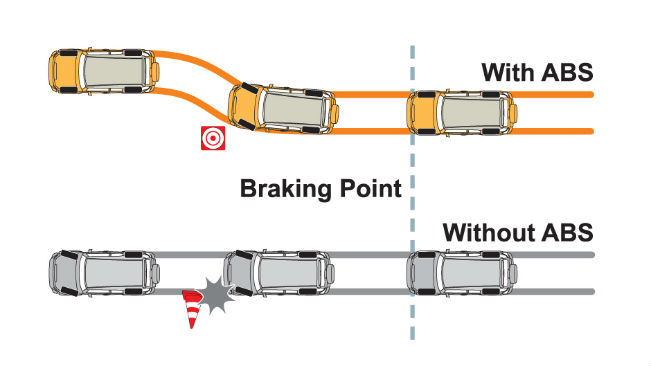How Your Car’s Anti-Lock Braking System Works
 Before Anti-lock Braking Systems (ABS) were installed on cars, drivers were told to rapidly pump their brakes if they felt a tire start to skid. Today, you don't need to pump your car's brakes when skidding, anti-lock braking systems do this for you. In this article, we'll learn about anti-lock braking systems and how they work.The operational theory starts with the fact that a skidding wheel has less traction than a non-skidding one. The best thing to do when a skid does occur is to slow your engine down and let the tires "grab". ABS systems do the same thing, they sense when a wheel is skidding during braking and then they pulse the brake automatically to regain traction. This not only allows you to stop in a shorter distance, you'll be able to regain your steering too. Here are four components we should quickly discuss:1) Speed Sensors - The ABS needs some way of knowing when a wheel is about to lock up. Speed sensors, which are located on each wheel assembly, provide this information.2) Brake Line Valves - There is a valve in the brake line of each brake controlled by the ABS. This electrically-controlled valve controls the brake pressure going to each brake assembly.3) Electric Pump - When a Brake Line Valve reduces the pressure in a brake line, there is an electric pump to bring the restore the pressure.4) ABS Controller - The ABS controller is a small computer. It runs the whole ABS system.The ABS Controller is the brain of the system. It constantly monitors the four wheel speed sensors, looking for speed decelerations in any of the four wheels that are out of the ordinary. The ABS controller knows that rapid deceleration is technically "impossible" under normal driving conditions, so it reduces the brake line pressure to the brake involved until it sees it speed up again. The result: this gives the system maximum braking power. When the ABS system is in operation you will feel a pulsing in the brake pedal; this comes from the rapid opening and closing of the valves.Have you ever wondered what you should do when your car starts to skid? First, do not pump your brakes! The ABS system does this for you. In an emergency stop in a car with ABS, you should just apply your brake pedal firmly and hold it while the ABS does all the work. You will feel a pulsing in the pedal that may be quite noticeable but this is completely normal so don't let off the brake. When your ABS system is functioning properly, you should have some steering control quickly return so use that to get back on course.
Before Anti-lock Braking Systems (ABS) were installed on cars, drivers were told to rapidly pump their brakes if they felt a tire start to skid. Today, you don't need to pump your car's brakes when skidding, anti-lock braking systems do this for you. In this article, we'll learn about anti-lock braking systems and how they work.The operational theory starts with the fact that a skidding wheel has less traction than a non-skidding one. The best thing to do when a skid does occur is to slow your engine down and let the tires "grab". ABS systems do the same thing, they sense when a wheel is skidding during braking and then they pulse the brake automatically to regain traction. This not only allows you to stop in a shorter distance, you'll be able to regain your steering too. Here are four components we should quickly discuss:1) Speed Sensors - The ABS needs some way of knowing when a wheel is about to lock up. Speed sensors, which are located on each wheel assembly, provide this information.2) Brake Line Valves - There is a valve in the brake line of each brake controlled by the ABS. This electrically-controlled valve controls the brake pressure going to each brake assembly.3) Electric Pump - When a Brake Line Valve reduces the pressure in a brake line, there is an electric pump to bring the restore the pressure.4) ABS Controller - The ABS controller is a small computer. It runs the whole ABS system.The ABS Controller is the brain of the system. It constantly monitors the four wheel speed sensors, looking for speed decelerations in any of the four wheels that are out of the ordinary. The ABS controller knows that rapid deceleration is technically "impossible" under normal driving conditions, so it reduces the brake line pressure to the brake involved until it sees it speed up again. The result: this gives the system maximum braking power. When the ABS system is in operation you will feel a pulsing in the brake pedal; this comes from the rapid opening and closing of the valves.Have you ever wondered what you should do when your car starts to skid? First, do not pump your brakes! The ABS system does this for you. In an emergency stop in a car with ABS, you should just apply your brake pedal firmly and hold it while the ABS does all the work. You will feel a pulsing in the pedal that may be quite noticeable but this is completely normal so don't let off the brake. When your ABS system is functioning properly, you should have some steering control quickly return so use that to get back on course.








